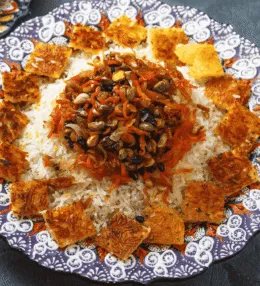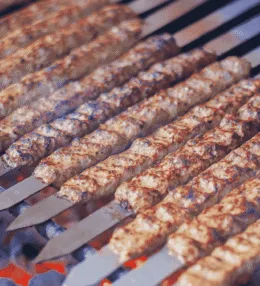
- View
Table of Contents
ToggleFocaccia is Italy in a tray. You lift a slice, and the olive oil sighs, the crumb springs, and the crust brings a gentle crunch. Rosemary perfumes the air, sea salt flickers on the surface, and every dimple holds flavour. It is easy to share, joyful to tear, and satisfying with almost any meal you can name.
Home cooks love how forgiving it is. The dough likes time and patience rather than fancy technique, so a beginner can get fine results. Serve it as a warm snack, a table bread, or a base for toppings. It suits a glass of wine, a bowl of soup, or a plate of ripe tomatoes with basil.
Travel through Italy and you meet many styles. Ligurian bakers favour a thin, tender crumb with generous oil. Puglia leans into rustic richness and tomatoes. In bakeries you will spot plain versions as well as onion, olive, or herb studded trays. All celebrate excellent oil and good salt.
Want to dive deeper into Italian cuisine? Don’t miss our post on 20 Traditional Italian Foods to Try
What Is Focaccia?
Focaccia is a flat oven baked Italian bread that sits somewhere between pizza dough and a traditional loaf. The dough gets pressed into a baking tray rather than shaped, creating its characteristic flat appearance and generous surface area for toppings.
The defining feature of focaccia is those distinctive dimples pressed into the dough before baking. These indentations aren’t just decorative; they create little pools where olive oil collects, infusing the bread with flavour and helping to create that perfectly crisp bottom.
Traditional focaccia rises to about two to three centimetres thick, though some regional varieties go thicker or thinner. The texture should be light and airy inside, with an open crumb structure full of irregular holes, whilst the outside develops a golden, slightly crisp crust.
Toppings vary tremendously depending on where you are in Italy. Rosemary and sea salt represent the classic combination, but you’ll also find versions topped with cherry tomatoes, olives, onions, or even grapes in certain areas during harvest season.
The bread gets drizzled generously with olive oil both before and after baking, which contributes to its tender crumb and rich flavour. This liberal use of quality olive oil is non-negotiable in authentic focaccia and separates it from other flatbreads.
Ingredients and Taste
Making focaccia requires surprisingly few ingredients, though each one plays a vital role. Strong white flour forms the base, providing the protein structure needed for that airy texture. Fresh or dried yeast causes the dough to rise and develop flavour.
Water hydrates the flour and activates the yeast, whilst a good amount of extra virgin olive oil makes the bread tender and adds its fruity, peppery notes throughout. Sea salt seasons the dough and often gets sprinkled on top as a finishing touch.
Fresh rosemary is the traditional herb of choice, its pine-like aroma complementing the olive oil beautifully. Some bakers add a touch of sugar or honey to the dough to feed the yeast and encourage browning, though this isn’t universal.
The taste of well-made focaccia is genuinely special. Your first bite delivers a contrast between the crispy, oil crisped exterior and the soft, almost fluffy interior. The bread tastes wheaty and slightly fermented, with those wonderful yeasty notes that come from proper proving.
Olive oil permeates every bite, lending richness without greasiness when done correctly. The rosemary provides aromatic punctuation, whilst flaky sea salt on top creates little bursts of savoury intensity. The overall effect is deeply satisfying and surprisingly complex.
What strikes people about good focaccia is how the simple ingredients create something greater than their sum. There’s a balance between richness and lightness, saltiness and subtle sweetness, crispness and softness that keeps you reaching for another piece.
The best focaccia has a golden bottom that’s achieved a lovely crunch from contact with the oil slicked pan. Meanwhile, the top stays tender and inviting, studded with herbs and glistening slightly from its final drizzle of oil.
A Taste of History
Focaccia’s roots reach back to ancient times, with many food historians believing it descends from breads made by the Etruscans or ancient Romans. These early flatbreads were cooked on hot stones or in the ashes of fires, a practical method for communities without ovens.
The name itself offers clues to this heritage. “Focaccia” derives from the Latin word “focus,” meaning hearth or fireplace, referring to where these breads were traditionally baked. This linguistic connection ties the bread directly to the domestic heart of Roman homes.
By medieval times, focaccia had evolved into something closer to what we recognise today. Ligurian bakers, particularly those in Genoa, developed their distinctive style of focaccia that would become famous throughout Italy and eventually the world.
Sailors departing from Genoese ports carried focaccia on their voyages because it kept reasonably well and provided sustaining nourishment. This helped spread knowledge of the bread to distant places and cemented its reputation as reliable, delicious fare.
Throughout the centuries, focaccia remained everyday food rather than something reserved for special occasions. Families made it at home, and neighbourhood bakeries produced batches daily. This accessibility helped embed it deeply in Italian culinary culture.
Different regions developed their own cherished variations. Recco became famous for focaccia col formaggio, stuffed with soft cheese. Apulia created focaccia barese with tomatoes and olives. Each variation reflected local ingredients and preferences whilst honouring the basic concept.
In recent decades, focaccia has experienced something of a renaissance beyond Italy. Artisan bakeries worldwide now produce their versions, and home bakers have embraced it as an achievable project that delivers professional results.
How to Make Focaccia (Herbed Bread)
Focaccia is a beloved Italian bread known for its airy crumb, golden crust, and generous drizzle of olive oil infused with herbs. Its simplicity lies in the dough, yet each rise builds depth of flavour and lightness. Expect soft, fragrant bread perfect for dipping, serving, or enjoying on its own. See the recipe card at the bottom for printable directions
Ingredients
- 300 g strong white bread flour
- 1 tsp fine sea salt
- 7 g instant yeast
- 200 ml warm water
- 2 tbsp extra virgin olive oil, plus extra for drizzling
- 1 tsp sugar
- 1 tbsp fresh rosemary, finely chopped (or 1 tsp dried rosemary)
- Flaky sea salt, for sprinkling
Cooking Instructions
Step 1: Prepare the yeast mixture
In a large bowl, combine the warm water, sugar, and yeast. Stir lightly and leave for 10 minutes until frothy. This activates the yeast and ensures the dough will rise properly.
Step 2: Mix the dough
Add the flour and fine sea salt to the yeast mixture, then pour in the olive oil. Mix with your hand or a wooden spoon until a sticky dough forms. The dough should feel soft but not wet.
Step 3: Knead until smooth
Transfer the dough onto a lightly floured surface and knead for about 10 minutes until smooth and elastic. Alternatively, use a mixer with a dough hook for 6–7 minutes. When pressed with a finger, the dough should spring back slightly.
Step 4: First rise
Lightly oil a clean bowl, place the dough inside, and cover with a damp cloth. Leave to rise in a warm place for about 1 hour, or until doubled in size. Avoid draughty areas to maintain even rising.
Step 5: Prepare the baking tin
Grease a 20 x 30 cm baking tin with olive oil. Once the dough has risen, gently deflate it with your hands and stretch it to fit the tin. Press evenly to create a uniform thickness.
Step 6: Create the dimples
With your fingertips, press deep indentations all over the dough surface. These dimples will hold pools of oil and herbs, which help flavour and texture the crust.
Step 7: Second rise
Cover the tin with a cloth and leave to rise again for about 30 minutes. This second rise ensures a soft and airy crumb while maintaining the bread’s structure.
Step 8: Add toppings
Preheat the oven to 220°C (200°C fan). Drizzle the top of the dough generously with olive oil, sprinkle with rosemary, and finish with a pinch of flaky sea salt. Press lightly so the herbs cling to the surface.
Step 9: Bake the focaccia
Bake for 20–25 minutes until golden brown and slightly crisp on top. The base should sound hollow when tapped, indicating it is baked through.
Step 10: Serve and enjoy
Remove from the oven and drizzle with a final touch of olive oil. Slice into squares or strips and serve warm. Focaccia pairs beautifully with soups, cheeses, or simply dipped in balsamic vinegar.
Variations and Substitutions
- Herbs: Replace rosemary with thyme, oregano, or sage for different aromatic profiles.
- Flour: Use half wholemeal flour for a rustic version with deeper flavour.
- Toppings: Add sliced olives, cherry tomatoes, or caramelised onions for regional variations.
- Oil: Sunflower or light olive oil can substitute extra virgin olive oil in a pinch.
Cooking Tips for Perfect Focaccia
- Use high quality olive oil for the best flavour and aroma.
- Let the dough rise fully to achieve the signature airy texture.
- Do not over flour the surface when kneading; slight stickiness helps the crumb stay soft.
- Sprinkle the sea salt just before baking to prevent it from dissolving into the dough.
- Brush with extra oil right after baking to keep the crust moist.
How to Store and Reheat
Let focaccia cool fully on a rack so steam escapes and the crust does not soften. Keep it at room temperature for a day, wrapped in paper then slipped into a loose bag. For longer keeping, freeze slices in a single layer, then store in a container. Thaw at room temperature before you warm it.
To refresh, use a hot oven. Heat to about two hundred and twenty degrees Celsius, place slices on a tray, and warm for five to eight minutes until the edges crisp again. A light flick of water under the tray can raise steam and revive the crumb. Avoid a microwave, which turns the crust tough.
If you like a near fresh finish, reheat in a heavy pan with a lid for a few minutes. The base regains crunch while gentle steam softens the interior. Brush with a little new oil, add a pinch of flaky salt, and the aroma leaps back. Serve at once, while the crust still whispers as you cut.

Italian Focaccia (Herbed Bread) Recipe
Ingredients
- 300 g strong white bread flour
- 1 tsp fine sea salt
- 7 g instant yeast
- 200 ml warm water
- 2 tbsp extra virgin olive oil plus extra for drizzling
- 1 tsp sugar
- 1 tbsp fresh rosemary finely chopped (or 1 tsp dried rosemary)
- Flaky sea salt for sprinkling
Instructions
- In a large bowl, combine the warm water, sugar, and yeast. Stir lightly and leave for 10 minutes until frothy. This activates the yeast and ensures the dough will rise properly.
- Add the flour and fine sea salt to the yeast mixture, then pour in the olive oil. Mix with your hand or a wooden spoon until a sticky dough forms. The dough should feel soft but not wet.
- Transfer the dough onto a lightly floured surface and knead for about 10 minutes until smooth and elastic. Alternatively, use a mixer with a dough hook for 6–7 minutes. When pressed with a finger, the dough should spring back slightly.
- Lightly oil a clean bowl, place the dough inside, and cover with a damp cloth. Leave to rise in a warm place for about 1 hour, or until doubled in size. Avoid draughty areas to maintain even rising.
- Grease a 20 x 30 cm baking tin with olive oil. Once the dough has risen, gently deflate it with your hands and stretch it to fit the tin. Press evenly to create a uniform thickness.
- With your fingertips, press deep indentations all over the dough surface. These dimples will hold pools of oil and herbs, which help flavour and texture the crust.
- Cover the tin with a cloth and leave to rise again for about 30 minutes. This second rise ensures a soft and airy crumb while maintaining the bread’s structure.
- Preheat the oven to 220°C (200°C fan). Drizzle the top of the dough generously with olive oil, sprinkle with rosemary, and finish with a pinch of flaky sea salt. Press lightly so the herbs cling to the surface.
- Bake for 20–25 minutes until golden brown and slightly crisp on top. The base should sound hollow when tapped, indicating it is baked through.
- Remove from the oven and drizzle with a final touch of olive oil. Slice into squares or strips and serve warm. Focaccia pairs beautifully with soups, cheeses, or simply dipped in balsamic vinegar.
Nutrition
You May Also Like



Italian Focaccia (Herbed Bread)
Follow The Directions




